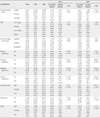Abstract
Purpose
The suicide rate of adolescents in Korea is increasing annually. Therefore, this research was done to identify the suicide attempt rate of middle and high school students and to identify factors that influence suicidal attempts.
Methods
The Korea Youth Health Risk Behavior Web-based Survey (2007) was used as data. Discriminant analysis and logistic regression were performed to analyze the data depending on gender to consider the gender difference in assessing the influence of each independent variable on suicidal attempts.
Results
Discriminant analysis according on gender showed that 13 factors correlated with suicidal attempts for boys, and 20 factors for girls. The most highly correlated factors were smoking, depression and inhalation experience. For inhalation experience, boys had 2.7 times higher possibility of suicide attempts (95% CI 1.8-3.0) and girls, a 2.4 times higher possibility (95% CI 1.7-3.5).
Conclusion
The results of the study indicate a need to classify adolescents for expectation of suicide risk and high danger for suicidal attempts through, and introduce suicide prevention programs for these adolescents. In particular, it is necessary to start intervention with students who smoke, have sexual and inhalation experiences and high levels of depression.
References
1. Cho SJ, Jeon HJ, Kim JK, Suh T, Kim SU, Harm BJ, et al. Prevalence of suicide behaviors (suicidal ideation and suicide attempt) and risk factors of suicide attempts in junior and high school adolescents. Journal of Korean Neuropsychiatric Association. 2002. 41:1142–1155.
2. Chun YJ, Lee SH. Analysis of variables related to adolescent's suicidal ideation. Korean Journal of Youth Studies. 2000. 7:221–246.
3. Daniel SS, Goldston DB. Interventions for suicidal youth: A review of the literature and developmental considerations. Suicide and Life-Threatening Behavior. 2009. 39:252–268. doi: 10.1521/suli.2009.39.3.252.
4. Dieserud G, Gerhardsen RM, Van den Weghe H, Corbett K. Adolescent suicide attempts in Bærum, Norway, 1984-2006. Crisis. 2010. 31:255–264.
5. Hong YS. The effect of life stress on adolescent suicidal behaviors and the buffering effect of problem-solving ability. Journal of the Korean Society of Child Welfare. 2005. 20:7–33.
6. Hong YS, Jeon SY. The effects of life stress and depression for adolescent suicidal ideation. Mental Health & Social Work. 2005. 19:125–149.
7. Horowitz LM, Ballard ED, Pao M. Suicide screening in schools, primary care and emergency departments. Current Opinion in Pediatrics. 2009. 21:620–627. doi: 10.1097/MOP.0b013e3283307a89.
8. Kang BS, Kim GS. Social science statistics analysis. 2003. Seoul: Freedom Academy.
9. Kelly TM, Cornelius JR, Lynch KG. Psychiatric and substance use disorders as risk factors for attempted suicide among adolescents: A case control study. Suicide & Life-Threatening Behavior. 2002. 32:301–312.
10. Kessler RC, Borges G, Walters EE. Prevalence of and risk factors for lifetime suicide attempts in the National Morbidity Survey. Archives of General Psychiatry. 1999. 56:617–626.
11. Kim BY, Lee CS. A meta-analysis of variables related to suicidal ideation in adolescents. Journal of Korean Academy of Nursing. 2009. 39:651–661. doi: 10.4040/jkan.2009.39.5.651.
12. Kim HJ. Effect factors of adolescences' suicide risk. Journal of the Korean Society of Child Welfare. 2008. 27:69–93.
13. Kim HS. Correlation between personality, family dynamic environment and suicidal attempt among Korean adolescents population. Journal of Korean Academy of Nursing. 2002. 32:231–242.
14. Kim HS, Kim HR, Park SK. Correlates of suicidal behaviors - comparative study between male adolescents with substance abuse problems and male adolescents with no substance abuse problems. Korean Journal of Social Welfare Studies. 2007. 34:273–306.
15. Kim KW, Chun MH. Study on the teenage suicide. Journal of the Korean Society of Child Welfare. 2000. 9:127–152.
16. Ko YY, Chung YJ. A study on the characteristics of responses to HFD test on high school students experiencing test-anxiety. Journal of Psychotherapy. 2009. 9:47–66.
17. Korea Centers for Disease Control and Prevention. The 2nd Korean National Adolescent Health Behavior Survey. 2007. Seoul: Author.
18. Korea Centers for Disease Control and Prevention. Using guidelines for The Korea Youth Health Risk Behavior Web-based Survey (KYHRBWS) raw data. 2009. Seoul: Author.
19. Kwak SJ, Yi Y, Jung HS. The analysis on factors related to suicide ideation of middle and high school students in Korea. Journal of the Korean Society of School Health. 2009. 22:103–111.
20. Lee E. Construction of a structural model about male and female adolescents' alienation, depression and suicidal thoughts. Journal of Korean Academy of Nursing. 2007. 37:576–585.
21. Lee H. Effect of socioeconomic status of family on adolescent suicidal ideation. 2006. Seoul: Seoul National University;Unpublished master's thesis.
22. Mäkikyrö TH, Hakko HH, Timonen MJ, Lappalainen JA, IIomäki RS, Marttunen MJ, et al. Smoking and suicidality among adolescent psychiatric patients. Journal of Adolescent Health. 2004. 34:250–253. doi: 10.1016/j.jadohealth.2003.06.008.
23. Nam SH. A study on psychosocial mechanism of copycat suicidal ideation among adolescents. The Journal of Humanities & Social Sciences Studies. 2008. 19:51–87.
24. Nrugham L, Herrestad H, Mehlum L. Suicidality among Norwegian youth: Review of research on risk factors and interventions. Nordic Journal of Psychiatry. 2010. 64:317–326. doi: 10.3109/08039481003628364.
25. Park E. The influencing factors on suicide attempt among adolescents in South Korea. Journal of Korean Academy of Nursing. 2008. 38:465–473. doi: 10.4040/jkan.2008.38.3.465.
26. Park HS. Validation of a path model on adolescents' suicidal ideation and violent behavior. Journal of Korean Academy of Nursing. 2007. 37:835–843.
27. Sandin B, Chorot P, Santed MA, Valiente RM, Joiner TE. Negative life events and adolescent suicidal behavior: A critical analysis from the stress process perspective. Journal of Adolescence. 1998. 21:415–426. doi: 10.1006/jado.1998.0172.
28. Yim ML. Relationship between suicidal ideation and stress, despair, and social support in adolescence. 2010. Seoul: Chung-Ang University;Unpublished master's thesis.




 PDF
PDF ePub
ePub Citation
Citation Print
Print







 XML Download
XML Download